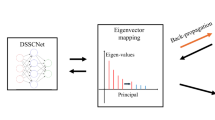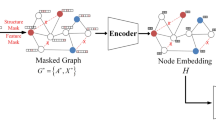Abstract
Graph embedding based learning method plays an increasingly significant role on dimensionality reduction (DR). However, the selection to neighbor parameters of graph is intractable. In this paper, we present a novel DR method called adaptive graph embedding discriminant projections (AGEDP). Compared with most existing DR methods based on graph embedding, such as marginal Fisher analysis which usually predefines the intraclass and interclass neighbor parameters, AGEDP applies all the homogeneous samples for constructing the intrinsic graph, and simultaneously selects heterogeneous samples within the neighborhood generated by the farthest homogeneous sample for constructing the penalty graph. Therefore, AGEDP not only greatly enhances the intraclass compactness and interclass separability, but also adaptively performs neighbor parameter selection which considers the fact that local manifold structure of each sample is generally different. Experiments on AR and COIL-20 datasets demonstrate the effectiveness of the proposed method for face recognition and object categorization, and especially under the interference of occlusion, noise and poses, it is superior to other graph embedding based methods with three different classifiers: nearest neighbor classifier, sparse representation classifier and linear regression classifier.












Similar content being viewed by others
References
Turk M, Pentland A (1991) Eigenfaces for recognition. J Cogn Neurosci 3(1):71–86
Belhumeur PN, Hepanha JP, Kriegman DJ (1997) Eigenfaces vs. fisherfaces: recognition using class specific linear projection. IEEE Trans Pattern Anal Mach Intell 19(7):711–720
Tenenbaum JB, deSilva V, Langford JC (2000) A global geometric framework for nonlinear dimensionality reduction. Science 290:2319–2323
Roweis ST, Saul LK (2000) Nonlinear dimensionality reduction by locally linear embedding. Science 290:2323–2326
Belkin M, Niyogi P (2003) Laplacian eigenmaps for dimensionality Reduction and data representation. Neural Comput 15(6):1373–1396
He X, Niyogi P (2003) Locality preserving projections. In: Advances in neural information processing system (NIPS) 16:100–115
Yan S, Xu D, Zhang B, Zhang H, Yang Q, Lin S (2007) Graph embedding and extension: a general framework for dimensionality reduction. IEEE Trans Pattern Anal Mach Intell 29(1):40–51
Yang J, Zhang D, Yang JY, Niu B (2007) Globally maximizing, locally minimizing: unsupervised discriminant projection with applications to face and palm biometrics. IEEE Trans Pattern Anal Mach Intell 29(4):650–664
Zhang ZY, Zha HY (2004) Principal manifolds and nonlinear dimensionality reduction by local tangent space alignment. SIAM J Sci Comput 26(1):313–338
Sun SL (2013) Tangent space intrinsic manifold regularization for data representation. In: Proceedings of the 1st IEEE China summit and international conference on signal and information processing: 179–183
He X, Cai D, Yan S, Zhang H (2005) Neighborhood preserving embedding. IEEE international conference on computer vision (ICCV): 1208–1213
Sugiyama M (2007) Dimensionality reduction of multimodal labeled data by local Fisher discriminant analysis. J Mach Learn Res 8:1027–1061
Lu G, Lin Z, Jin Z (2010) Face recognition using discriminant locality preserving projections based on maximum margin criterion. Pattern Recognit 43(10):3572–3579
Wang J, Hua J (2011) Supervised discriminant projection with its application to face recognition. Neural Process Lett 34:1–12
Yang B, Chen S (2010) Sample-dependent graph construction with application to dimensionality reduction. Neurocomputing 74:301–314
Huang P, Tang Z, Chen C, Cheng X (2011) Nearest-neighbor classifier motivated marginal discriminant projections for face recognition. Front Comput Sci China 5(4):419–428
Belkin M, Niyogi P (2002) Laplacian eigenmaps and spectral techniques for embedding and clustering. Advances in neural information processing systems 14
Nene SA, Nayar SK, Murase H (1996) Columbia object image library (COIL-20). Technical, Report CUCS-005-96
Wright J, Yang A, Ganesh A, Sastry S, Ma Y (2009) Robust face recognition via sparse representation. IEEE Trans Pattern Anal Mach Intell 31(2):210–227
Naseem I, Togneri R, Bennamoun M (2010) Linear regression for face recognition. IEEE Trans Pattern Anal Mach Intell 32(11):2106–2112
Conover WJ (1999) Practical nonparametric statistics. Wiley, New York
Diethe T, Hardoon DR, Shawe-Taylor J (2008) Multiview Fisher discriminant analysis. NIPS Workshop Learning from Multiple Sources
Chen QN, Sun SL (2009) Hierarchical multi-view Fisher discriminant analysis. Lecture notes in computer science, vol 5864. Springer, Berlin, pp 289–298
Acknowledgments
This work was supported by the National Natural Science Foundation of China (Nos. 61071137, 61071138, 61027004), and the 973 Program of China (Project No. 2010CB327900). The authors would like to thank the anonymous reviewers for their valuable comments and suggestions to improve the quality of this paper.
Author information
Authors and Affiliations
Corresponding author
Rights and permissions
About this article
Cite this article
Shi, J., Jiang, Z. & Feng, H. Adaptive Graph Embedding Discriminant Projections. Neural Process Lett 40, 211–226 (2014). https://doi.org/10.1007/s11063-013-9323-8
Published:
Issue Date:
DOI: https://doi.org/10.1007/s11063-013-9323-8




